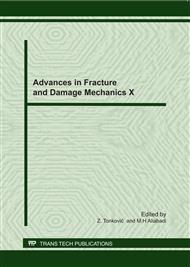p.387
p.391
p.395
p.399
p.403
p.407
p.411
p.416
p.420
Valuation of TMF Lifetime Calculation Methods and their Limitations of Usability
Abstract:
Cyclic loading of metallic engineering components at constant elevated or fluctuating temperature causes a complex evolution of damage which can hardly be described. At the same time the thermal expansion is restricted in some regions, due to the complex geometry of the components. Therefore, mechanical stresses occur and cyclic plastic deformation leads to thermo-mechanical fatigue (TMF) of the material. A careful analysis and comparison of the experimental results, based on a systematical variation of the relevant influence factors, allow to develop empirical models for computing the fatigue life of thermo-mechanical loaded components made of Ni alloys (IN718, Ni200/201). Different lifetime calculation methods were executed and analyzed to fulfil the requirements for the fatigue analysis of components made of these alloys. In addition, the model parameters can be optimized using these results. Based on the parameters, which define the usability of the investigated lifetime models, e.g. temperature, stress, plastic strain, the limiting combination of the parameters can be described. This graphical representation of the “border line” or limiting combination can also be used for any other materials. The results show that the main lifetime calculation models can only applied in a limited range. This limited range is mainly defined by temperature, strain constraining and their combination.
Info:
Periodical:
Pages:
403-406
Citation:
Online since:
September 2011
Authors:
Price:
Сopyright:
© 2012 Trans Tech Publications Ltd. All Rights Reserved
Share:
Citation:


